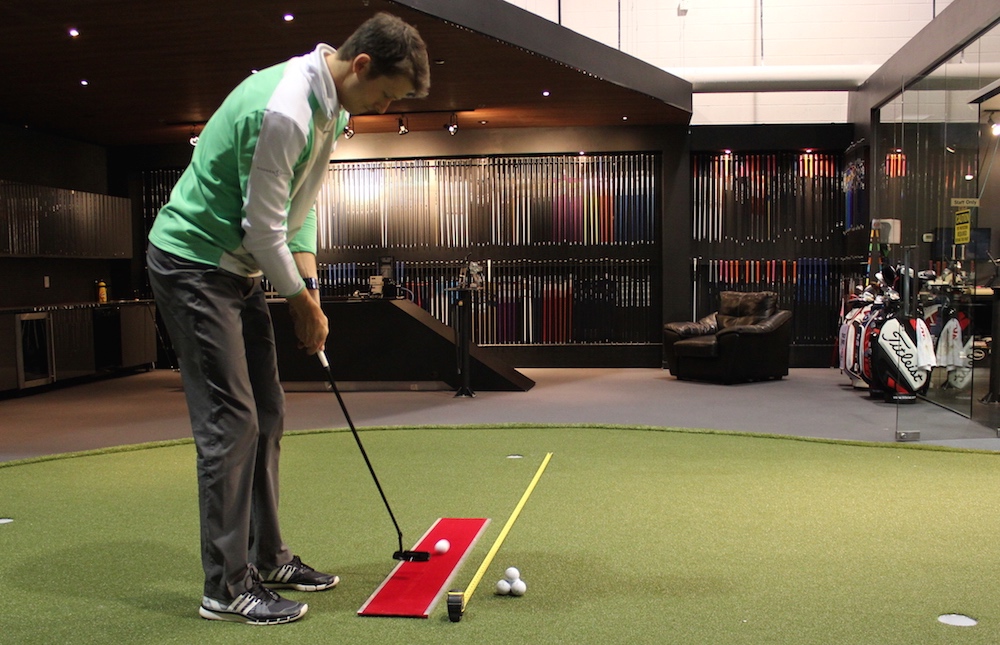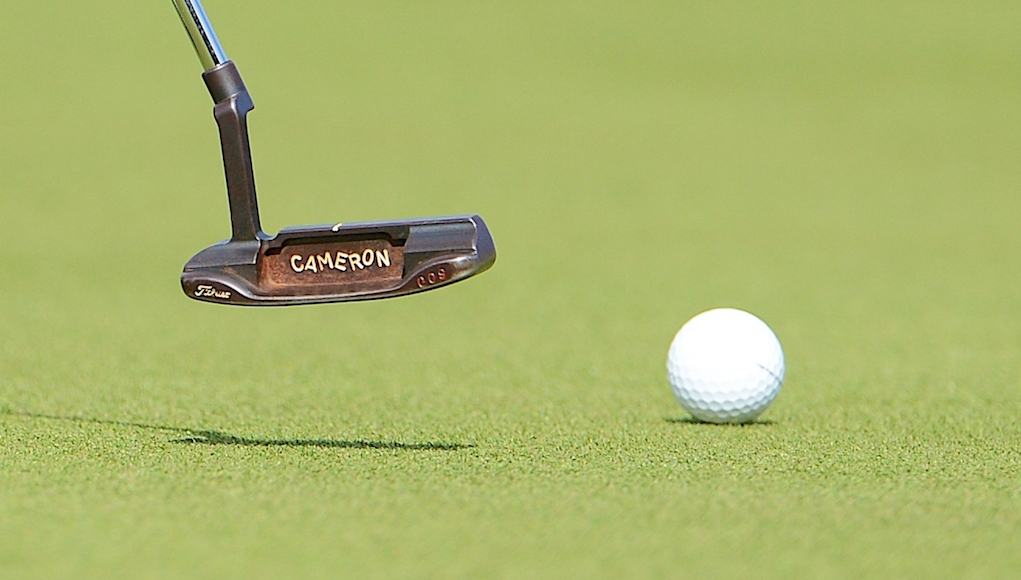Opinion & Analysis
The key to putter fitting? Know your roll

This is the second installment of a four-part series from Modern Golf on putter fitting and the Quintic System.
Find a busy practice putting green, and it’s almost guaranteed that you’ll see at least a few golfers obsessing over the motion of their putting stroke. They’re usually the ones who are using some kind of training aid to help them groove their stroke in a certain way.
For many golfer, it can be time well spent. But what they might not know is that the way their putter moves is only half the equation to good putting. Did you know that two putts with the same clubhead speed can travel significantly different distances? Did you also know that most golfers actually do a good job of consistently swinging the putter through at their desired speed? So why do so many golfers have problems with their distance control? The other half of the equation is controlling what is called their ball roll.
How do golfers control how their ball roll? How should the ball be rolling? It is a very difficult question to answer without using high-speed cameras and motion capturing. Using a system called Quintic, we provide golfers the knowledge and data they need to putt their best. Understanding this data will improve your game.
The image below shows what an ideal 8-foot putt looks like on our Quintic System.
Forward Rotation
As you can see, the ball instantly started to rotate forward off the putter face. A ball that has negative initial ball roll, or “backspin,” will lose speed and can deflect offline. Having the ball rotate forward off the face will give players better distance control with their putts because the ball will lose less energy and stay on its intended line longer. This will aid the ball in rolling over debris and other imperfections on the green such as ball marks, spike marks, etc.
Having anywhere from +25 rpm to +50 rpm initial ball roll is ideal. Any higher and the ball will roll out longer because it will be carrying more momentum. This can make downhill 5 footers scarier than they already are. With an rpm under +20 rpm, the ball doesn’t carry as much momentum to the hole.
Launch
The ball was launched at about 1.75 degrees. An ideal launch angle on most greens is between 0.75 degrees and 2 degrees. Much like a driver, controlling launch has a big influence on how far the ball will travel. That is because on the green, a ball will sit in a small depression as a result of gravity. The ball needs to be launched out of this depression — and not too high or too low. Optimal launch should change depending on the blade length of the grass and the type of putting surface. On lush greens with a longer blade length, the ball will sit in a deeper depression. On firm greens with a short blade length, the ball will not sit in such a deep depression, and for that reason not as much launch is required.
The image below shows what happens to a putt that has a launch angle that is too high.
Zero Skid
Minimal skid is ideal. On a well struck putt, there should be less than 10 percent skid for the total distance the ball travels. So on an 8-foot putt, ideally there should be less than 10 inches of skid (see first image). Once “zero skid” occurs, the ball starts rolling on top of the grass smoothly. When there is too much skid, the result is a loss of distance and ball speed. Every time the ball bounces and strikes the putting surface it loses energy — energy that has been factored into your putt for speed and distance. These putts tend to come up short and offline, and this often happens with long putts or lag putts.
Below are images of a “dew board.” The board simulates putting through an early morning dew where it is easy to see launch and skid. There are two visible lines on the board. The putt that has a flat and consistent line has optimal launch and minimal skid. The putt that looks dotted or chattered has launched too high, increasing the zero skid parameter. The dots are where the ball has struck the putting surface and continues to hop until it reaches zero skid.
Every putt, at some point, reaches zero skid. Reducing the amount of time it takes for the ball to reach zero skid will ensure that the ball will lose minimal energy and carry more momentum to the hole.
Impact Ratio
This refers to how efficiently clubhead speed is converted into ball speed. For all of those Trackman users out there, this is the same as smash factor. It is a simple calculation: ball speed divided by clubhead speed. Controlling the speed that the ball comes off the face is crucial. This is achieved when the center mass of the club head makes contact with the center mass of the golf ball. Any off-center strike results in a loss of ball speed and face deflection, causing the ball to roll offline with less speed.
We’ve all hit full shots that weren’t solidly struck and they come up short of our target. The exact same thing happens when we don’t hit a putt solid, but it’s much harder to feel the mishit because the clubhead speed is much slower through impact with a putter. This is where most golfers struggle.
The face of the putter also needs to be square to the path of the club. Otherwise, you’ll see a glancing blow that also reduces ball speed. The type of putter a player uses also has an effect on ball speed. Putters with softer inserts reduce ball speed because of reduced energy transfer from the club head to the ball. To illustrate where you strike the ball on the clubface, spray the face of the putter with Doctor Scholl’s foot spray. It will show you where the ball is making contact with the face, and has minimal effect on ball speed and friction.
Certainly there are other parameters to consider, but this article should provide golfers with a general concept that they may not have considered in the past. Without knowing what the ball is doing, it is very difficult to teach someone proper putting mechanics. Players who have a better understanding of how the ball is rolling have a better chance of improving their game on the greens. Therefore, go get fit for a putter and KNOW YOUR ROLL.
Call or email to book your appointment today at Modern Golf.
Related
Opinion & Analysis
The 2 primary challenges golf equipment companies face

As the editor-in-chief of this website and an observer of the GolfWRX forums and other online golf equipment discourse for over a decade, I’m pretty well attuned to the grunts and grumbles of a significant portion of the golf equipment purchasing spectrum. And before you accuse me of lording above all in some digital ivory tower, I’d like to offer that I worked at golf courses (public and private) for years prior to picking up my pen, so I’m well-versed in the non-degenerate golf equipment consumers out there. I touched (green)grass (retail)!
Complaints about the ills of and related to the OEMs usually follow some version of: Product cycles are too short for real innovation, tour equipment isn’t the same as retail (which is largely not true, by the way), too much is invested in marketing and not enough in R&D, top staffer X hasn’t even put the new driver in play, so it’s obviously not superior to the previous generation, prices are too high, and on and on.
Without digging into the merits of any of these claims, which I believe are mostly red herrings, I’d like to bring into view of our rangefinder what I believe to be the two primary difficulties golf equipment companies face.
One: As Terry Koehler, back when he was the CEO of Ben Hogan, told me at the time of the Ft Worth irons launch, if you can’t regularly hit the golf ball in a coin-sized area in the middle of the face, there’s not a ton that iron technology can do for you. Now, this is less true now with respect to irons than when he said it, and is less and less true by degrees as the clubs get larger (utilities, fairways, hybrids, drivers), but there remains a great deal of golf equipment truth in that statement. Think about it — which is to say, in TL;DR fashion, get lessons from a qualified instructor who will teach you about the fundamentals of repeatable impact and how the golf swing works, not just offer band-aid fixes. If you can’t repeatably deliver the golf club to the golf ball in something resembling the manner it was designed for, how can you expect to be getting the most out of the club — put another way, the maximum value from your investment?
Similarly, game improvement equipment can only improve your game if you game it. In other words, get fit for the clubs you ought to be playing rather than filling the bag with the ones you wish you could hit or used to be able to hit. Of course, don’t do this if you don’t care about performance and just want to hit a forged blade while playing off an 18 handicap. That’s absolutely fine. There were plenty of members in clubs back in the day playing Hogan Apex or Mizuno MP-32 irons who had no business doing so from a ballstriking standpoint, but they enjoyed their look, feel, and complementary qualities to their Gatsby hats and cashmere sweaters. Do what brings you a measure of joy in this maddening game.
Now, the second issue. This is not a plea for non-conforming equipment; rather, it is a statement of fact. USGA/R&A limits on every facet of golf equipment are detrimental to golf equipment manufacturers. Sure, you know this, but do you think about it as it applies to almost every element of equipment? A 500cc driver would be inherently more forgiving than a 460cc, as one with a COR measurement in excess of 0.83. 50-inch shafts. Box grooves. And on and on.
Would fewer regulations be objectively bad for the game? Would this erode its soul? Fortunately, that’s beside the point of this exercise, which is merely to point out the facts. The fact, in this case, is that equipment restrictions and regulations are the slaughterbench of an abundance of innovation in the golf equipment space. Is this for the best? Well, now I’ve asked the question twice and might as well give a partial response, I guess my answer to that would be, “It depends on what type of golf you’re playing and who you’re playing it with.”
For my part, I don’t mind embarrassing myself with vintage blades and persimmons chasing after the quasi-spiritual elevation of a well-struck shot, but that’s just me. Plenty of folks don’t give a damn if their grooves are conforming. Plenty of folks think the folks in Liberty Corner ought to add a prison to the museum for such offences. And those are just a few of the considerations for the amateur game — which doesn’t get inside the gallery ropes of the pro game…
Different strokes in the game of golf, in my humble opinion.
Anyway, I believe equipment company engineers are genuinely trying to build better equipment year over year. The marketing departments are trying to find ways to make this equipment appeal to the broadest segment of the golf market possible. All of this against (1) the backdrop of — at least for now — firm product cycles. And golfers who, with their ~15 average handicap (men), for the most part, are not striping the golf ball like Tiger in his prime and seem to have less and less time year over year to practice and improve. (2) Regulations that massively restrict what they’re able to do…
That’s the landscape as I see it and the real headwinds for golf equipment companies. No doubt, there’s more I haven’t considered, but I think the previous is a better — and better faith — point of departure when formulating any serious commentary on the golf equipment world than some of the more cynical and conspiratorial takes I hear.
Agree? Disagree? Think I’m worthy of an Adam Hadwin-esque security guard tackle? Let me know in the comments.
@golfoncbs The infamous Adam Hadwin tackle ? #golf #fyp #canada #pgatour #adamhadwin ? Ghibli-style nostalgic waltz – MaSssuguMusic
Podcasts
Fore Love of Golf: Introducing a new club concept

Episode #16 brings us Cliff McKinney. Cliff is the founder of Old Charlie Golf Club, a new club, and concept, to be built in the Florida panhandle. The model is quite interesting and aims to make great, private golf more affordable. We hope you enjoy the show!
Opinion & Analysis
On Scottie Scheffler wondering ‘What’s the point of winning?’

Last week, I came across a reel from BBC Sport on Instagram featuring Scottie Scheffler speaking to the media ahead of The Open at Royal Portrush. In it, he shared that he often wonders what the point is of wanting to win tournaments so badly — especially when he knows, deep down, that it doesn’t lead to a truly fulfilling life.
View this post on Instagram
“Is it great to be able to win tournaments and to accomplish the things I have in the game of golf? Yeah, it brings tears to my eyes just to think about it because I’ve literally worked my entire life to be good at this sport,” Scheffler said. “To have that kind of sense of accomplishment, I think, is a pretty cool feeling. To get to live out your dreams is very special, but at the end of the day, I’m not out here to inspire the next generation of golfers. I’m not out here to inspire someone to be the best player in the world, because what’s the point?”
Ironically — or perhaps perfectly — he went on to win the claret jug.
That question — what’s the point of winning? — cuts straight to the heart of the human journey.
As someone who’s spent over two decades in the trenches of professional golf, and in deep study of the mental, emotional, and spiritual dimensions of the game, I see Scottie’s inner conflict as a sign of soul evolution in motion.
I came to golf late. I wasn’t a junior standout or college All-American. At 27, I left a steady corporate job to see if I could be on the PGA Tour starting as a 14-handicap, average-length hitter. Over the years, my journey has been defined less by trophies and more by the relentless effort to navigate the deeply inequitable and gated system of professional golf — an effort that ultimately turned inward and helped me evolve as both a golfer and a person.
One perspective that helped me make sense of this inner dissonance around competition and our culture’s tendency to overvalue winning is the idea of soul evolution.
The University of Virginia’s Division of Perceptual Studies has done extensive research on reincarnation, and Netflix’s Surviving Death (Episode 6) explores the topic, too. Whether you take it literally or metaphorically, the idea that we’re on a long arc of growth — from beginner to sage elder — offers a profound perspective.
If you accept the premise literally, then terms like “young soul” and “old soul” start to hold meaning. However, even if we set the word “soul” aside, it’s easy to see that different levels of life experience produce different worldviews.
Newer souls — or people in earlier stages of their development — may be curious and kind but still lack discernment or depth. There is a naivety, and they don’t yet question as deeply, tending to see things in black and white, partly because certainty feels safer than confronting the unknown.
As we gain more experience, we begin to experiment. We test limits. We chase extreme external goals — sometimes at the expense of health, relationships, or inner peace — still operating from hunger, ambition, and the fragility of the ego.
It’s a necessary stage, but often a turbulent and unfulfilling one.
David Duval fell off the map after reaching World No. 1. Bubba Watson had his own “Is this it?” moment with his caddie, Ted Scott, after winning the Masters.
In Aaron Rodgers: Enigma, reflecting on his 2011 Super Bowl win, Rodgers said:
“Now I’ve accomplished the only thing that I really, really wanted to do in my life. Now what? I was like, ‘Did I aim at the wrong thing? Did I spend too much time thinking about stuff that ultimately doesn’t give you true happiness?’”
Jim Carrey once said, “I think everybody should get rich and famous and do everything they ever dreamed of so they can see that it’s not the answer.”
Eventually, though, something shifts.
We begin to see in shades of gray. Winning, dominating, accumulating—these pursuits lose their shine. The rewards feel more fleeting. Living in a constant state of fight-or-flight makes us feel alive, yes, but not happy and joyful.
Compassion begins to replace ambition. Love, presence, and gratitude become more fulfilling than status, profits, or trophies. We crave balance over burnout. Collaboration over competition. Meaning over metrics.
Interestingly, if we zoom out, we can apply this same model to nations and cultures. Countries, like people, have a collective “soul stage” made up of the individuals within them.
Take the United States, for example. I’d place it as a mid-level soul: highly competitive and deeply driven, but still learning emotional maturity. Still uncomfortable with nuance. Still believing that more is always better. Despite its global wins, the U.S. currently ranks just 23rd in happiness (as of 2025). You might liken it to a gifted teenager—bold, eager, and ambitious, but angsty and still figuring out how to live well and in balance. As much as a parent wants to protect their child, sometimes the child has to make their own mistakes to truly grow.
So when Scottie Scheffler wonders what the point of winning is, I don’t see someone losing strength.
I see someone evolving.
He’s beginning to look beyond the leaderboard. Beyond metrics of success that carry a lower vibration. And yet, in a poetic twist, Scheffler did go on to win The Open. But that only reinforces the point: even at the pinnacle, the question remains. And if more of us in the golf and sports world — and in U.S. culture at large — started asking similar questions, we might discover that the more meaningful trophy isn’t about accumulating or beating others at all costs.
It’s about awakening and evolving to something more than winning could ever promise.
























Scooter McGavin
Feb 27, 2015 at 11:20 am
There is some good info on this article. I also agree that people can tend to overlook putter roll. I’d be curious for a little more info that goes into greater depth about its role in the fitting process with respect to different models’ grooves, inserts, centers of gravity, etc. and how it would directly affect one’s putter choice. Cheers!